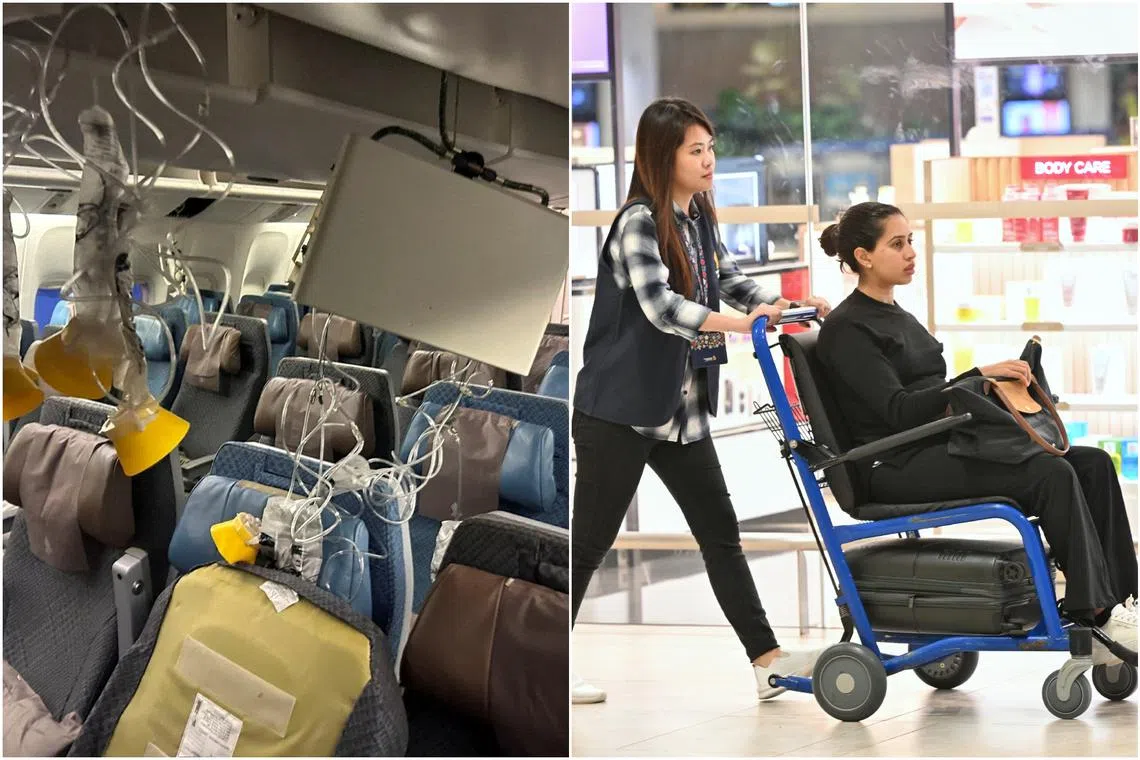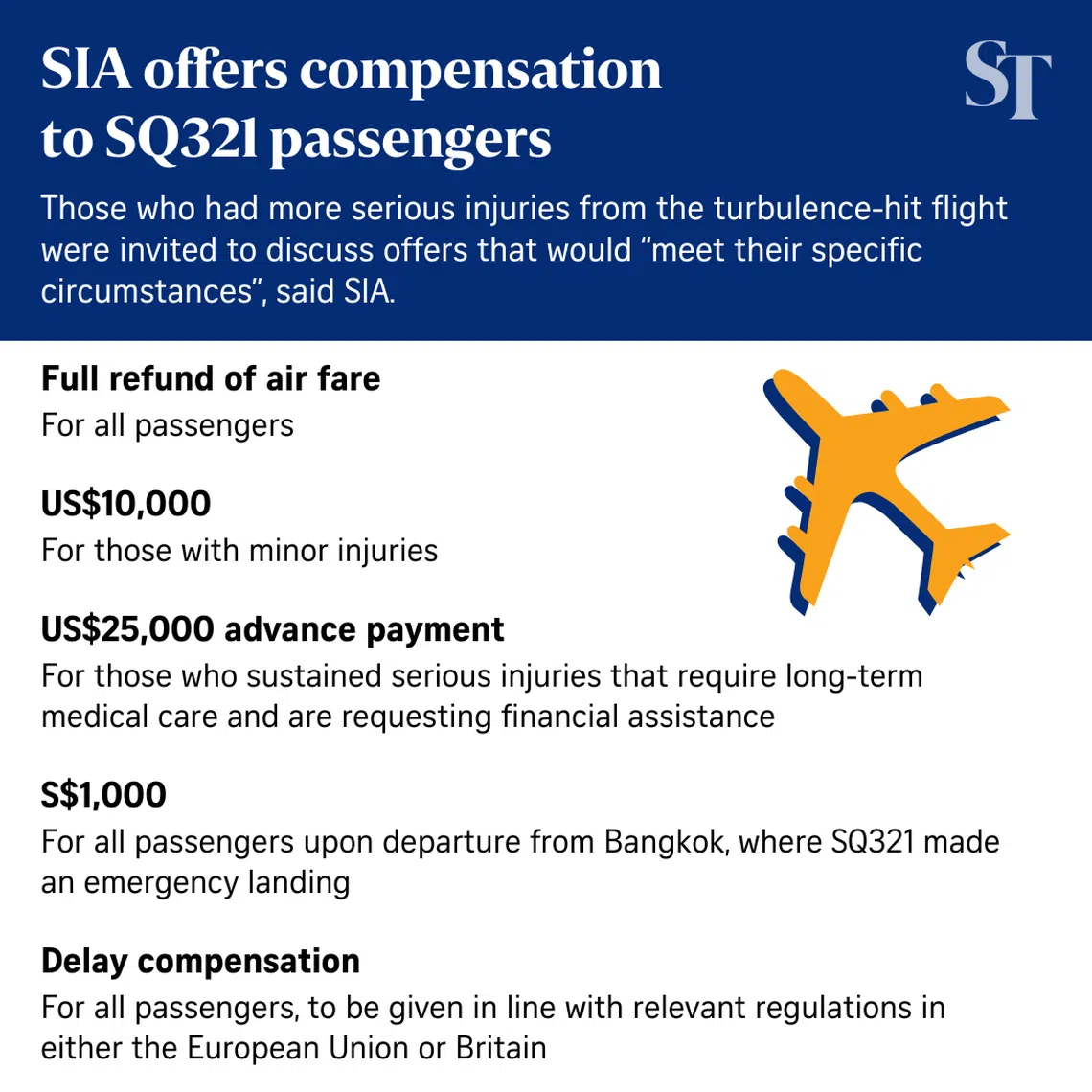SIA offers compensation to passengers of turbulence-hit SQ321; US$10k for those with minor injuries
Sign up now: Get ST's newsletters delivered to your inbox

SIA said it will also provide a full refund of the airfare to all passengers who were on the flight.
PHOTOS: REUTERS, ST FILE
Follow topic:
SINGAPORE - Singapore Airlines (SIA) has sent out offers of compensation to passengers on board the turbulence-hit SQ321,
The national carrier said in a Facebook post on June 11 that those who had more serious injuries were invited to discuss compensation offers that would “meet their specific circumstances”.
It added that it has offered US$25,000 as an advance payment for passengers who suffered serious injuries that require long-term medical care and are requesting financial help.
The payment will address their immediate needs and be part of the final compensation they receive.
Besides compensation, SIA said it will also provide a full refund of the airfare to all passengers who were on the flight, which experienced “sudden extreme turbulence” over the Irrawaddy Basin in Myanmar on May 21 as the Boeing 777-300ER aircraft made its way to Singapore from London.
The pilot declared a medical emergency and landed the plane at Bangkok’s Suvarnabhumi Airport.
A British passenger, 73-year-old Geoffrey Kitchen,
There were 211 passengers and 18 crew members on board, and the injured were taken to Samitivej Srinakarin Hospital, Samitivej Sukhumvit Hospital and Bangkok Hospital for treatment.

The refund will also be given to passengers who were not injured.
SIA said there will also be “delay compensation” given, in line with regulations in either the European Union or Britain.
Under these regulations, passengers may be entitled to financial compensation if their flight is delayed on arrival by three hours or more.
Passengers had also been given $1,000 each upon departing from Bangkok, where SQ321 made an emergency landing. The payments were to cover their immediate expenses.
SIA said it has been covering the medical expenses of those injured, and arranged for family members and loved ones to travel to Bangkok upon request.
“All affected passengers should have received their offers of compensation via e-mail, along with information on how they may proceed with their claims,” the airline said.
One offer, dated June 10 and seen by The Straits Times, showed that SIA would pay €600 (S$870) as delay compensation, in line with European regulations.
According to the e-mail sent to a passenger, the passenger has 21 days to accept the offer.
Passengers who wish to make claims for any unforeseen costs arising directly from the turbulence incident were also told to inform the airline and provide supporting evidence for further consideration.
Those who need further help or have questions or concerns have been asked to reply to the e-mail sent by SIA or contact the carrier through an e-mail address provided.
Public relations professional Amelia Lim, who was on board flight SQ321, said the compensation offer she received from SIA did not include the US$10,000 sum for minor injuries, even though she had suffered scratches to her face, whiplash, a concussion and chest trauma due to the incident.
She has contacted SIA to find out what constitutes a minor injury and whether she would qualify for the US$10,000 sum. Barring this uncertainty, the 43-year-old Malaysian national told ST she is generally pleased with the outcome.
“There have been a lot of follow-ups and calls from SIA’s end, whether it is to reimburse my medical bills or items that I lost during the flight,” said Ms Lim, who returned to Singapore on a relief SIA flight that landed on May 22.
“Credit where credit’s due, I didn’t expect this level of care,” she added.
Asked how it came up with the compensation amounts, SIA said the sums are determined by the severity of each passenger’s injuries, based on the information provided by the respective medical institutions so far.
“We recognise that passengers with more serious injuries may require further support tailored to their individual circumstances. SIA has invited these passengers to discuss the compensation offer when (they) are well enough and ready to do so,” said a spokeswoman, adding that details of the compensation offers will be discussed directly with the affected passengers.
Citing privacy reasons, SIA said it could not disclose details about the number of passengers who have accepted the compensation offers.
The airline noted that it has a comprehensive insurance policy in place covering incidents such as that involving SQ321.
It did not directly answer questions about whether there are terms and conditions attached to the compensation offers, and whether they will have an impact on current and future legal claims.
National University of Singapore aviation law professor Alan Tan said the US$10,000 compensation offered to passengers with minor injuries is appropriate and generous.
SIA’s offer of a full fare refund and the $1,000 given to passengers for their immediate expenses are also good gestures, he added.
Meanwhile, the delay compensation of €600 per passenger is an expected outlay for SIA, given the disruptions caused to travel plans. While it could raise the defence of extraordinary circumstances for this, Prof Tan said it is wise for the airline to forgo it.
“The incident was a serious one and attracted worldwide attention and scrutiny. For these reasons, SIA would want to be seen to be doing more than its best to care for the affected passengers,” the professor said.
He added: “In fact, the level of compensation could well be a benchmark for any similar future cases.”
Additional reporting by Carmen Sin


